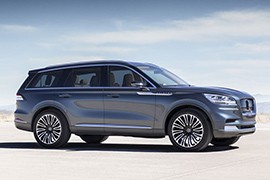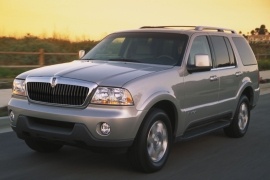LINCOLN Aviator Models/Series Timeline, Specifications & Photos
First production year: 2002
Engines: Gasoline, Hybrid gasoline
Body style: SUV (Sports Utility Vehicle)
Lincoln first offered the Aviator nameplate on a large three-row SUV back in the early 2000s, but the model's lack of success saw it being taken out of production after less than four years on the market. More than a decade later, Lincoln realized that it's so infatuated with the Aviator moniker that it developed a brand new SUV to wear it once more. Just like its predecessor, the all-new Aviator is a mid-sized three-row SUV that sits right under the Navigator in the Lincoln modern SUV lineup.
While naturally aspirated V8s were a commonality on American mid-size and full-size SUVs in the early 2000s, the second-generation Lincoln Aviator has an engine lineup that only comprises twin-turbocharged six-cylinders. The entry level model is powered by a twin-turbocharged 3.0-liter V6 with 400 horsepower and 400 lb-ft of torque, sent to all four wheels through a 10-speed automatic transmission developed in-house by Ford. The top of the range model is a plug-in hybrid version that gets its own nomenclature (Aviator Grand Touring), and comes with 450 horsepower and no less than 600 lb-ft of torque while using a lot less fuel than the standard model. While the model's exterior follows the same design language as its bigger brother, the Navigator, but with more aeronautical influences, the interior has its own style.
Ford decided to try its luck in the mid-size segment of the premium SUVs and launched the Lincoln Aviator in 2002 as a 2003 model year, based on the same platform as the Ford Explorer.
The world had enough MPVs of all sizes, and people asked for something just as good as carrying people as protecting them. While a minivan didn't look so trustworthy in terms of safety, even though they were, an SUV inspired more confidence in customers. Moreover, even though Ford already was quite successful with the Explorer, the market asked for something more opulent, but the Navigator was just too big.
Here comes the Aviator, a truck-based vehicle with body-on-frame construction but a look that definitely belongs to the premium segment. The massive chromed grille was flanked by a pair of headlights that resembled other Lincoln vehicles. To emphasize the car's SUV character, the carmaker added a body-colored bumper with a gray, scratch-resistant lower area. At the back, the carmaker added big taillights split between the tailgate and the quarter panels.
Inside, the Aviator offered room for seven passengers in a leather-wrapped interior. The driver was spoiled with adjustable lumbar support and inflatable bolsters. Since it was Lincoln's first step into the mid-SUV segment, it tried to offer as much as it could from its flagship SUV, the Navigator. And, in some way, it did. The tall center console sported the gear selector and a pair of cup holders. In addition, the center stack showed a clean layout in a minimalist design. The upper cover hid the stereo.
Under the hood, Lincoln used the well-known 4.6-liter V8 from Ford that developed 302 hp (306 PS) sent to the rear or to both axles via a five-speed automatic transmission.

